Extremely low temperatures. Gusty wind and incessant snow. No shelter, no fuel, and no food. Threatening wild animals. It is hard to imagine conditions worse than those in the farthest north. Yet people have lived there for thousands of years. How is that possible?
The first inhabitants appeared in the distant arctic and sub-arctic areas about 4.5 thousand. years ago. The ancestors of today's Inuit, Chukchi, Evenks and Aleuts, displaced by the expansive Asiatic tribes coming from the south, left their former headquarters and migrated north as the glaciers shrink and recede.
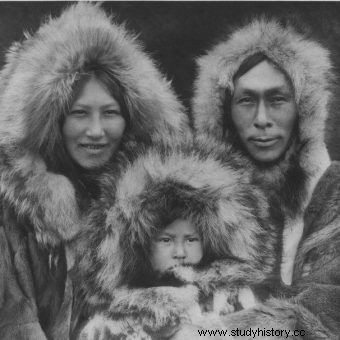
Looking at this happy family, it's hard to believe what the Inuit had to struggle with on a daily basis. Photo from 1930.
Then they crossed the then small and ice-covered Bering Strait, passing from Asia to the American continent; for Alaska today. As the traces of camps discovered by archaeologists show, from there they gradually moved along the shores of the polar sea, inhabiting countless islands of the Arctic Archipelago. Finally, via the Melville Peninsula and Ellesmere Land, they reached Greenland.
Minus 60 degrees Celsius
The conditions people found in the North were more than harsh. The term "ice hell" accurately reflects their character. In the Arctic, in the polar region, there are only two seasons:summer and winter - the former lasting only two months. In winter, the temperature can drop to minus 60 degrees Celsius. In summer, the highest reading of the thermometer is just plus 10 degrees. For many months, the sun does not appear at all. However, snowfall and strong winds causing blizzards are frequent.
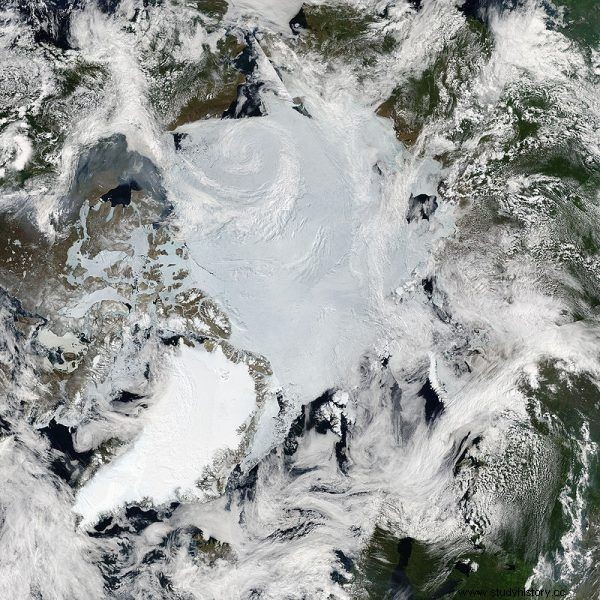
The conditions in this ice hell are truly terrifying. Only a few managed to adapt to them in order to survive everyday life. Arctic satellite image mosaic.
In some areas, snowstorms can last up to 100 days a year. With heavy snowstorms, visibility drops to almost zero and it is impossible to function. The wind sometimes carries ice needles that hurt the skin painfully. Frosty air burns the respiratory tract. Strong frost weakens blood circulation and causes severe frostbite. On the other hand, in "better" weather, people are at risk of snow blindness, which is a painful burn of the cornea and retina of the eye caused by UV-B radiation. The snow that covers everything reflects up to 85 percent. solar radiation.
Snow cover and low temperatures make it impossible to cultivate the land. From the beginning, the inhabitants of the North were doomed only to what they managed to hunt or catch. Getting food was not easy, because it required hunting skills:strength, reflexes and skill in using weapons. And when you try to hunt animals like a polar bear, a walrus or a whale, sometimes the hunter himself died.
A diet composed almost entirely of meat could also lead to a variety of diseases. In turn, the complete lack of trees made it problematic to build a shelter and to provide fuel for heating and preparing food. All these extreme conditions meant that a person's chance of survival in the North was much lower than in other parts of the world. Only the toughest could survive in such conditions. Or the best adapted.
Natural born survivors
This is what the people who settled in the far North turned out to be. Over the millennia, they developed specific mechanisms to survive in a polar climate. For the Inuit are short and stocky. A fine figure requires less work of the heart to maintain blood circulation and therefore warmth. Therefore, in parts of the body exposed to cold (face, hands, feet) they have an increased blood flow than in the average European.
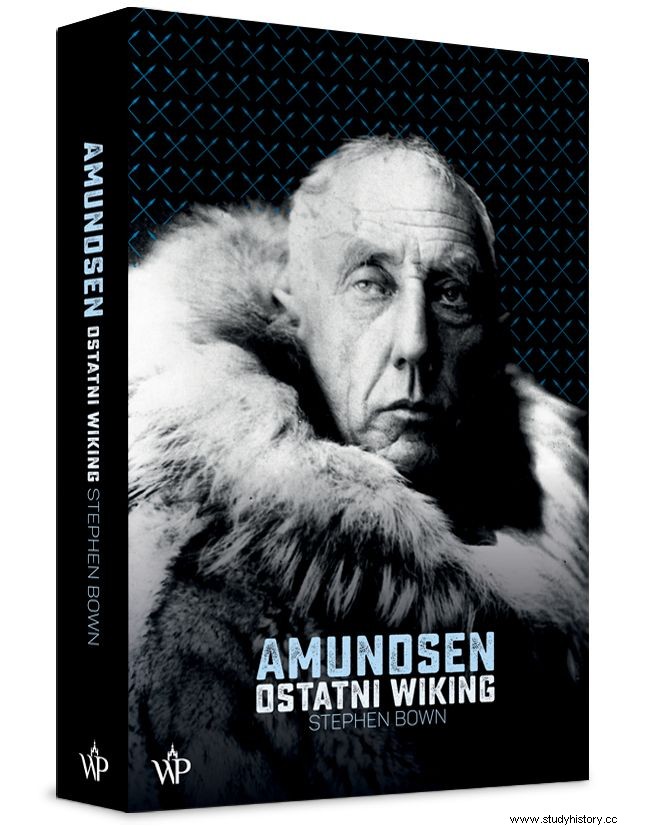
The article was inspired by the book by Stephen Brown "Amundsen. The Last Viking "(Wydawnictwo Poznańskie 2018), telling the story of a man who became a legend during his lifetime.
A flattened nose, on the other hand, makes the air warm much better before reaching the lungs. Thanks to the appropriate genes, the Inuit organism easily assimilates a high-fat meat diet that is harmful to other people. They also have large and efficient livers, thanks to which their bodies can convert proteins into carbohydrates that are lacking in the daily diet.
I can't hear footsteps in bear shoes
Adaptation to arctic conditions, apart from biology, had to include also the skillful organization of the material aspects of life. Northerners improved their clothing, homes, hunting gear, and mobility to best survive in the Ice Hell. Centuries of experience resulted in the natural creation of optimal solutions that work well in extreme winter conditions.
Take, for example, such clothing. Inuit wore "underwear" made of painstakingly sewn bird skins, folded down inside. He was wearing an anorak and white bearskin pants over the top. They were heavy, but the snow did not stick to the bristles. In summer, lighter pants made of seal skins or caribou (tundra reindeer) were worn and were worn with fur on the outside. The Inuit boots were also made of seal skin and consisted of two parts:the inner (body hair) and the outer (hair on the top).
The skin of the seal is waterproof and does not slip on ice, and the shoe keeps warmth perfectly, especially if it is padded with dry grass or musk ox hair. In turn, winter boots made of bear skin muffled the footsteps of a sneaking hunter. The famous Norwegian polar explorer Roald Amundsen admired the clothes of the Inuit.
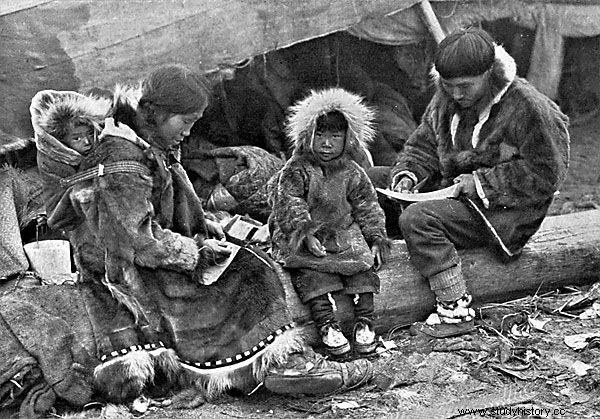
Most of the garments of the Inuit were made of seal skins. Each element was carefully considered for the weather conditions in the ice hell they live in.
My experience shows that (...) Inuit dress definitely surpasses European dress. However, you should only wear local clothes or not wear them at all. Every connection is bad. Woolen underwear absorbs all sweat and makes the outerwear wet quickly. A man dressed entirely in reindeer skin, such as an Inuit, in a garment loose enough to allow air to circulate between the layers of clothing, will generally be dry. (…) Let's add that the skins are completely windproof, which is of course very important - we read the words of the Norwegian traveler in his latest biography, entitled " Amundsen. The Last Viking ”From Stephen R. Bowna.
Disgusting Inuit black pudding
White travelers who came into contact with the Inuit and other northern inhabitants were shocked by their culinary habits. The natives not only ate most of the meat raw, but also some of their "dishes" could make you sick. Amundsen described one of these "specials".
Well, after hunting the caribou, the hunters cut open its belly and at once ate some of its guts, selecting it with their hands. They also scooped up blood which they poured into the animal's stomach, mixed the contents with a bone, and then simply consumed it ... "The dish prepared in this way is Inuit black pudding," wrote the Norwegian explorer. It was also common for the Inuit to eat rotten, spoiled or frozen meat.
I will give my wife a small fee
Due to the harsh living conditions, strong social bonds developed among the Inuit. Collaboration, mutual assistance and sacrifice for the tribe were key and constant elements of everyday life. A specific manifestation of this community was the custom of giving children up for adoption to other families in order to maintain social balance, as well as the practice of ... exchanging wives . This is how the author of his latest biography, Stephen R. Bown, writes about Amundsen's observations on this subject:
Noted how common wife swapping and bigamy are. Husbands made their women available for a small fee, which the polar explorer commented as follows:"A wife must obey, but I doubt she would do it of her own free will."

Bigamy and the exchange of wives was normal among the Inuit. But not only. The men, for a small fee, also 'made their women available' to strangers.
The book also says that Amundsen himself did not resist the temptation and, during a research expedition on the "Gjøa" in 1906, he had sexual contacts with Inuit women. According to local sources, after the departure of the Norwegians a local woman named Queleoq gave birth to the son of a Norwegian traveler, Luke Iquallaq . In the Inuit settlement of Gjøahavn beyond the Arctic Circle, back in the 1970s, several people claimed to be the grandchildren of the famous explorer.
The Inuit perfected many other practical skills. For example, the construction of a kayak necessary in the Arctic Archipelago. Its light, flexible skeleton was made of pieces of wood washed ashore by the sea. The structure was covered with smoothly tanned seal skins, carefully stitched to keep water out.
Walrus bones were placed on the bow and stern as bumpers. Narwhal tusks were attached to the bottom to protect the canoe against ice floes. You got into it through a narrow round opening. The hunter put his anorak on its protruding edges and tied the whole thing tightly with a thong. Thanks to this, he formed a single, indivisible and waterproof unit with his boat. He could maneuver it very well and swim very quickly.
Don't underestimate the natives
Some 19th and 20th century polar explorers made use of the skills of the Inuit and other northern peoples. From his first expeditions, Amundsen watched with curiosity about the indigenous people and drew invaluable knowledge from them. He watched them hunt, build igloos, use dogs, and drive a dog sled. This is what Stephen R. Bown writes about it in his latest book " Amundsen. The Last Viking ":
The Norwegian wanted to learn from the Inuit how to navigate and live in the polar region. (...) At first he did not do well, but later he learned new techniques from the Inuit, he mastered, among other things, their dog sled driving method and learned how they manage to survive in the north. The real benefit of the two years in Gjøahavn was not for Amundsen the opportunity to make tedious magnetic and meteorological measurements, but to learn about the culture and learn the Inuit knowledge .
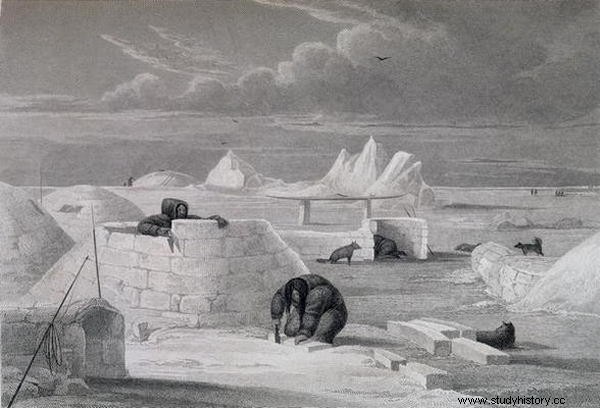
Amundsen won the pole primarily through the use of Inuit knowledge. Illustrated is the painting by George Francis Lyon "Inuit Building an Igloo" (1824).
Amundsen used the experience gained with the Inuit in the North during his successful expedition to the South Pole. Robert Scott, the Norwegian's rival in the race for its conquest, found out how the disregard for the knowledge of the natives ends. The British expedition turned out to be one big failure. Only five Brits reached the Pole on foot, pulling the sleigh themselves. There they found a Norwegian flag and a letter from Amundsen. On the way back, they all died of hunger, cold and exhaustion.
Bibliography:
- Stephen R. Bown, Amundsen. The Last Viking , Poznań 2018.
- Alina and Czesław Centkiewicz, Surrounded by great cold , Warsaw 1970.
- Marco Nazarri , Arctic. The land of eternal ice , Warsaw 1998.
